Gensco Chisels
Gensco chisels were made by Eskilstunasteel, a company located in Torshälla, Sweden just a short distance north of Eskilstuna. They were made primarily for export to the United States from around 1948 to the early 1960’s.
Eskilstunasteel has produced chisels since 1936, including the “Eskilstunasteel Garanti” brand and the “Esteel” brand. However, the earliest mention that I have seen of their “Gensco” chisel brand was in the 1946 U.S. wholesaler and dealer price list below.
The company that imported the chisels from Eskilstunasteel in Sweden to the U.S. was the General Steel Warehouse Company Inc., Gensco Tool Division. They were located in Chicago, Illinois — first at 1830 North Kostner Avenue in 1946 and then at 1832 North Kostner Avenue from 1949 on. This company marketed several Swedish hand tools including chisels, Sloyd knives, Mora hunting knives, and Bushman Swedish bow saws. While the Gensco chisels were manufactured and exported by Eskilstunasteel, the other items were made by other Swedish manufacturers.
The first Gensco chisels had very attractive masur (curly) birch handles and came in graduated widths from 1/4″ to 2″. They were tanged and bevelled-edge butt chisels — the only style that was ever ever available in the Gensco brand. Below is a 1948 Popular Mechanics ad showing the newly-introduced chisel.
The Gensco chisels still had masur birch handles in 1949, according to the Popular Mechanics ad shown below. The chisel illustration shows a stamp on the front of the blade, but I have never seen a Gensco chisel with a stamp there. It may have just been artistic license.
 February 1949 – Popular Mechanics
February 1949 – Popular Mechanics
I really like the looks of the masur birch-handled Gensco chisels. They often used highly-figured and nicely finished masur birch and applied a colorful decal to the handle. Although the chisels were made in Sweden, the decal was printed in the U.S. and likely applied to the chisel handles when they reached the U.S.
 Gensco Masur Birch-Handled Chisel – Front and Back
Gensco Masur Birch-Handled Chisel – Front and Back
The birch-handled Gensco chisels have a steel hoop at the top which is pierced and pinned in place by two small nails. The handles are typically ornate masur birch, although sometimes the birch is on the plain side. Some good examples of the handle decals can be seen below. The brass ferrules at the base of the handle vary in appearance. Some have medium to coarse vertical knurling on them and some have finer diagonal knurling on them.
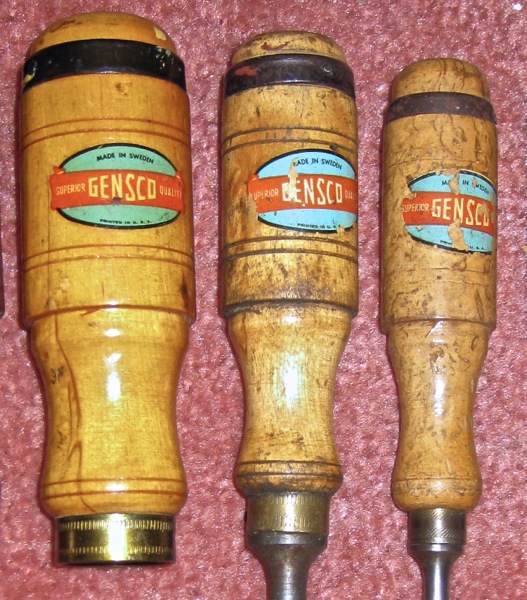 Gensco Wood Handles and Ferrules – Photo Courtesy of Randall Nelson
Gensco Wood Handles and Ferrules – Photo Courtesy of Randall Nelson
Here is a close up of the colorful Gensco decal. It reads “MADE IN SWEDEN” | “SUPERIOR GENSCO QUALITY” | “PRINTED IN U. S. A”.
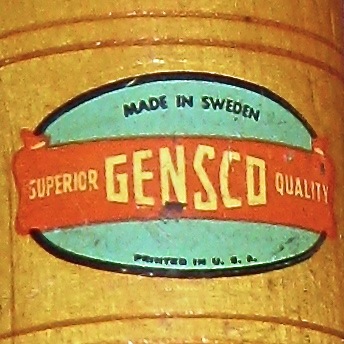 Gensco Decal – Photo Courtesy of Randall Nelson
Gensco Decal – Photo Courtesy of Randall Nelson
Gensco stamped their brand information on most of their blades. (They etched it on some of the narrower blades.) Here is an example of a Gensco stamp running lengthwise along the chisel blade. The stamp reads “ESKILTUNASTEEL” | “GENSCO” | “MADE IN SWEDEN”.
 Blade Stamp on Birch-Handled Gensco
Blade Stamp on Birch-Handled Gensco
This blade stamp reads the same as the one above, but runs across the width of this wider blade.
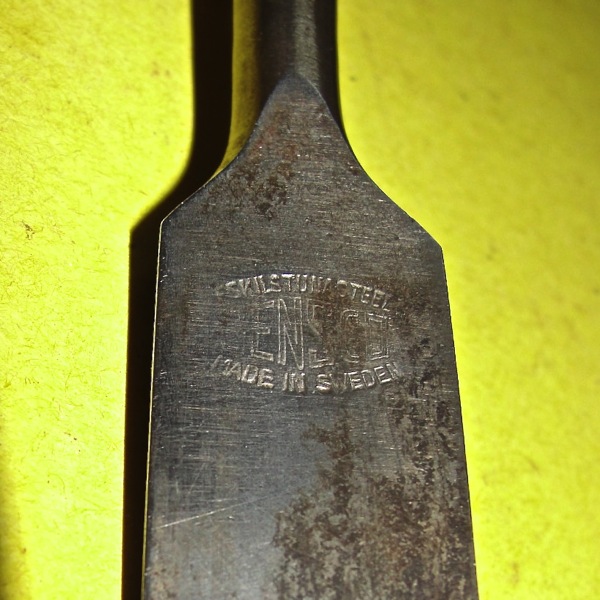 Blade Stamp on Wider Birch-Handled Gensco
Blade Stamp on Wider Birch-Handled Gensco
Some narrower Gensco blades were etched rather than stamped, as shown below. The stamp reads “ESKILTUNASTEEL” | “MADE IN SWEDEN”.
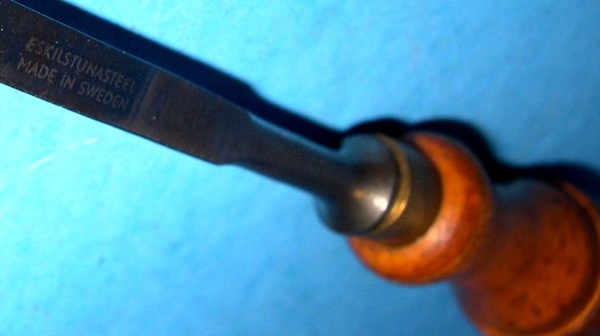 Etched Blade Stamp on Narrow Wood-Handled Gensco
Etched Blade Stamp on Narrow Wood-Handled Gensco
Here is an example of a box used to ship wood-handled Gensco chisels some time between 1946 and 1950. The front of the box shows a masur birch-handled chisel, complete with a steel ring on the top. There are also “Esteel” logos on the paper tape wrapped around the centre of the box.
Here is a closer look at one of the “Esteel” logos on the tape.
This early box had “GENERAL STEEL WAREHOUSE Co. INC.” | “CHICAGO 39 ILL.” printed below the logo in the upper left corner.
Popular Mechanics ads in the U.S. show that the wood-handled Gensco chisels were replaced by ones with yellow plastic handles in 1950.
According to the ad below, the chisels were available in the 11 sizes from 1/4″ up to 2″. Although not stated in the ad, these sizes included: 1/4″, 5/16″, 3/8″, 1/2″, 5/8″, 3/4″, 7/8″, 1″, 1-1/4″, 1-1/2″, 2″.
 April 1950 – Popular Mechanics
April 1950 – Popular Mechanics
A close look at the handle reveals that the printing on the plastic handle says “GENSCO – CHICAGO”. And the stamp on the front of the blade, although blurry, reads “MADE IN SWEDEN”. I think that both of these imprints may have been artistic interpretation only. I have never seen Gensco chisels with those handle or blade imprints. Still, I can’t say with 100% certainty that those imprints don’t exist.
I believe that the early handle stamp on the Gensco yellow plastic chisels looks like the one below. It’s printed from the bottom of the chisel handle to the top and reads “SWEDISH <GENSCO logo> STEEL”. I haven’t seen a lot of these handle stamps around and I believe that they were only made sometime between 1950 and 1952.
 Closeup of early Gensco handle stamp
Closeup of early Gensco handle stamp
By January 1952 the imprint on the Gensco chisel handles had changed. They were now oriented from left to right on the plastic handle and read <GENSCO logo> | “SWEDISH” | “STEEL”.
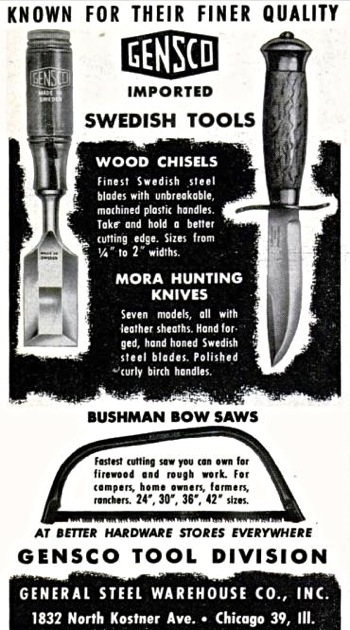 January 1952 – Popular Mechanics
January 1952 – Popular Mechanics
Here is a closeup of the chisel in the above ad.
Here’s a mint example of the Gensco handle stamp.
Once again the Popular Mechanics ad above shows “MADE IN SWEDEN” stamped on the chisel blade. I don’t believe that blade stamp stamp was ever used by Gensco. All of the blades stamps on yellow plastic-handled Gensco chisels that I have seen look like the ones shown below.
By September 1952, Gensco had begun imprinting the chisel’s width on the very top of its chisels.
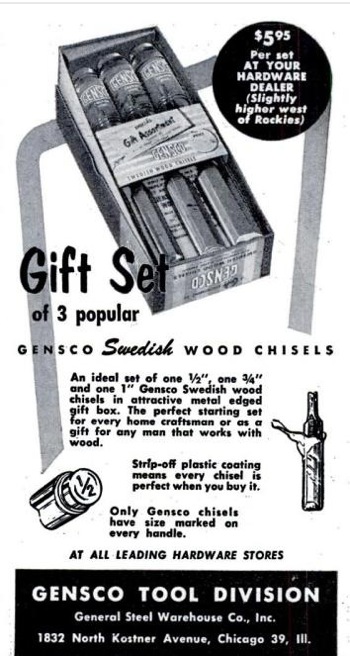 September 1952 – Popular Mechanics
September 1952 – Popular Mechanics
Imprinting the chisel blade width on the top of the chisels sounds like it might be a good idea. However, the marks were difficult to see since they were just stamped and not filled in with a contrasting color. Also, the mark tended to disappear as the top of the handle got bashed more and more by a steel hammer. The fourth chisel from the left show how the top of the handles would begin to deteriorate when pounded.
The boxed set of 3 chisels shown in the September 1952 ad above was probably aimed at the Christmas market and was priced at $5.95 east of the Rocky Mountains.
By November 1953, Gensco chisel ads were mentioning that the plastic chisel handles were made from “Tenite”. Tenite is the brand name of the wood-based cellulose plastic (cellulose acetate) developed by the Eastman Chemical Company in 1929.
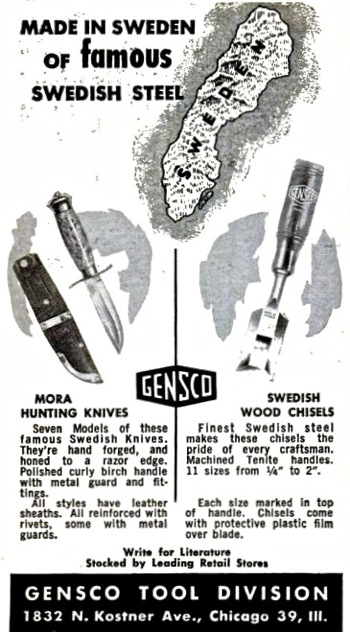 November 1953 – Popular Mechanics
November 1953 – Popular Mechanics
Gensco advertisements in Popular Mechanics did not mention any changes or innovations again until April 1957 when two notable things were mentioned: (1) “Tennite II” and (2) the availability of chisel sets in tool pouches and tool rolls.
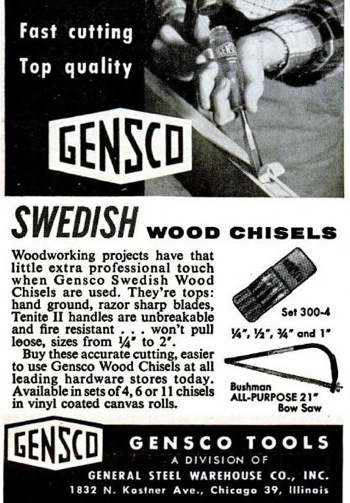 April 1957 – Popular Mechanics
April 1957 – Popular Mechanics
Gensco chisel handles were now being made of “Tenite II”. Tenite II had the advantage of not being as flammable as Tenite, which is very flammable … don’t ask me how I know 🙂 . Tennite II was also reputed to resist deterioration from use and natural aging better. Tennite II was developed by Eastman Kodak in 1938 and is also known as cellulose acetate butyrate.
The second thing announced was that Gensco chisels were now available in sets of 4, 6, and 11 that came in vinyl-coated pouches and tool rolls.
The Gensco #300-4 chisel pouch contained four chisels in the following sizes: 1/4″, 1/2″, 3/4″, and 1″.
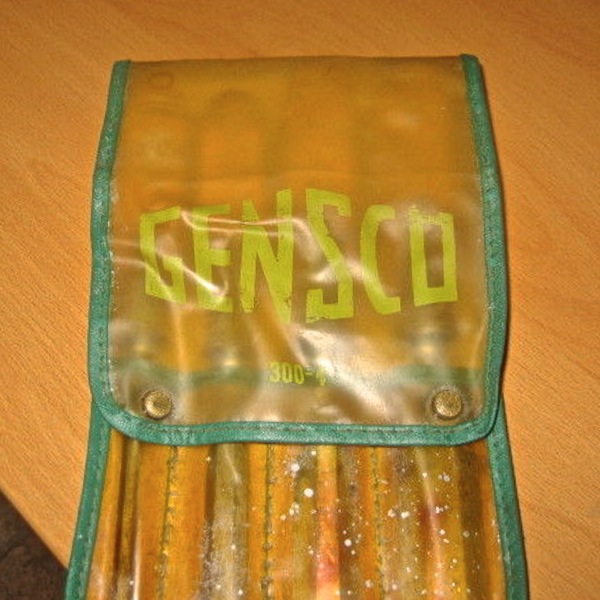 Closed Gensco #300-4 Four-Piece Tool Pouch
Closed Gensco #300-4 Four-Piece Tool Pouch
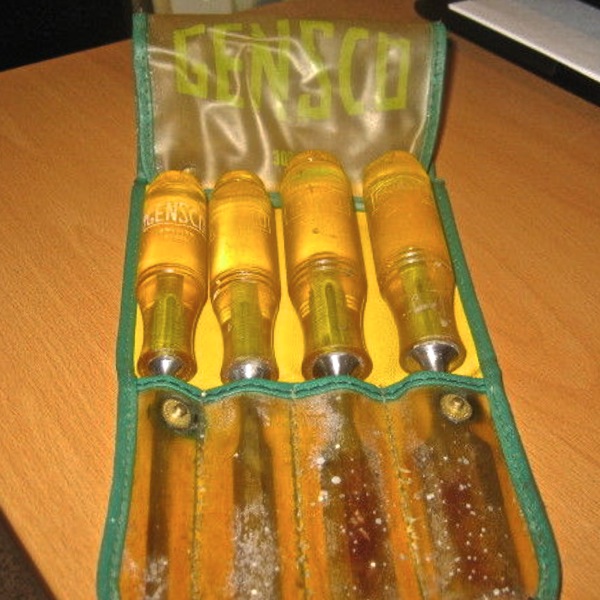 Open Gensco 300-4 Four-Piece Tool Pouch
Open Gensco 300-4 Four-Piece Tool Pouch
The Gensco #300-6 chisel tool roll contained six chisels in the following sizes: 1/4″, 1/2″, 3/4″, 1″, 1-1/4″, 1-1/2″.
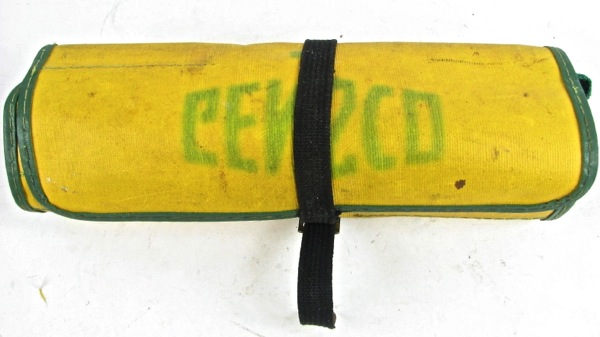 Gensco 300-6 Six-Piece Tool Roll
Gensco 300-6 Six-Piece Tool Roll
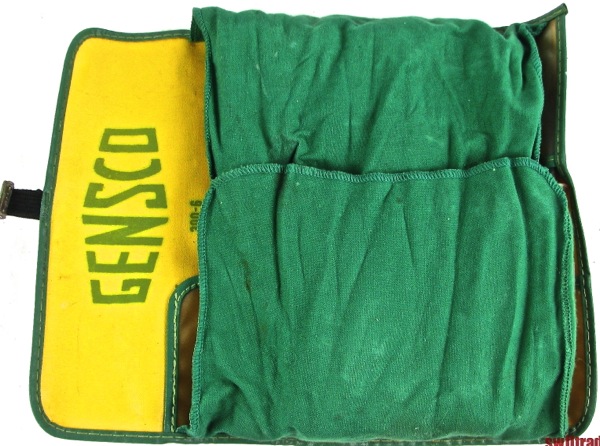 Unrolled Gensco 300-6 Six-Piece Tool Roll
Unrolled Gensco 300-6 Six-Piece Tool Roll
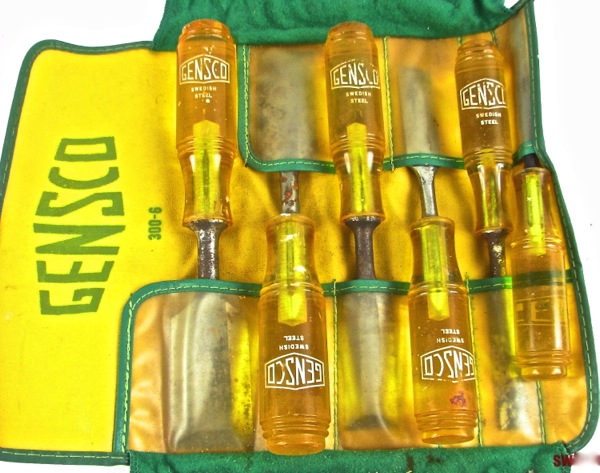 Open Gensco 300-6 Six-Piece Tool Roll
Open Gensco 300-6 Six-Piece Tool Roll
The Gensco #300-11 tool roll included all 11 Gensco chisels in the following sizes: 1/4″, 5/16″, 3/8″, 1/2″, 5/8″, 3/4″, 7/8″, 1″, 1-1/4″, 1-1/2″, 2″.
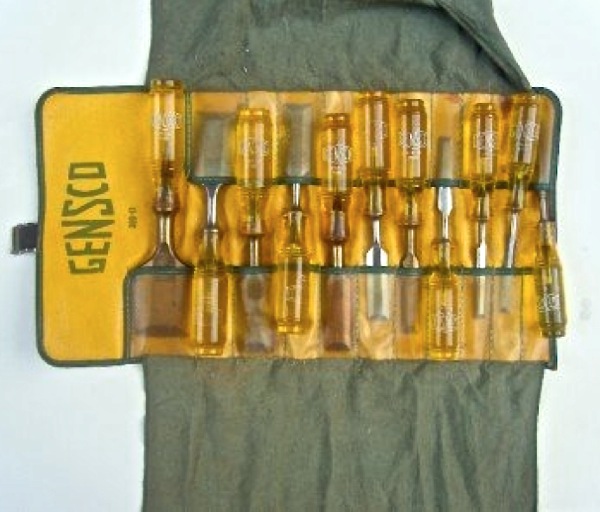 Open Gensco 300-11 Eleven Piece Tool Roll
Open Gensco 300-11 Eleven Piece Tool Roll
In additon to tool pouches and rolls, the yellow-handled Gensco chisels were also shipped in boxes. Below is an example of minty Gensco chisels and the box they came in. Unlike the box shown previously for the wood-handled Gensco chisels, this one has “GENSCO TOOL DIV.” and “1830 N. KOSTNER AVE.” below the Gensco logo in the upper left corner instead of “GENERAL STEEL WAREHOUSE Co. INC.”.
Most Gensco boxes for the plastice-handled chisels are more likely to look like the worn one below. The chisels still look pretty nice, though.
This label was inside the box and shows the complete range of sizes for all 11 Gensco chisels.
Below is the last Popular Mechanics ad that I’ve been able to find for Gensco chisels. It was run in February 1958. I assume that it was one of the last ones run by the General Steel Warehouse Company Inc. since Eskilstunasteel was bought out by Bahco in 1959.
 February 1958 – Popular Mechanics
February 1958 – Popular Mechanics
The Gensco chisel brand seemed to survive for only a short while after the 1959 buyout by Bahco, although some odd and interesting variations showed up before they disappeared.
Below is an unusual A. B. Bahco version of Gensco chisels that were produced in the very early 1960’s. In addition to showing the A. B. Bahco name on the upper left corner of the box lid, the name and address below the Gensco logo now reads: “General Swedish Hdwe. Corp.” | “1161 McCabe Ave.” | “Elk Grove, Ill. 60007”. Prior to the Bacho buyout, the U.S. Distributor for Gensco chisels was the General Steel Warehouse Company Inc., Gensco Tool Division located in Chicago, Illinois. I presume that the General Swedish Hardware Corporation was Bahco’s distributor in the U.S.
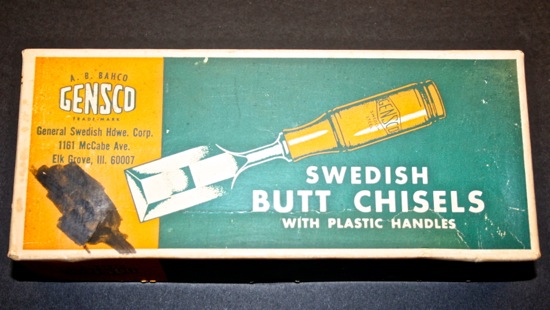 Lid of Bahco’s Gensco Chisel Box
Lid of Bahco’s Gensco Chisel Box
 Left Side of Bahco’s Gensco Chisel Box
Left Side of Bahco’s Gensco Chisel Box
While still sporting the familiar Gensco logo on the plastic handle, the blade is etched (not stamped) with Jernbolaget trademark and associated information: “1030” “1/4″ 5mm” <Jernbolaget logo> “SWEDEN”. The four chisels in the box all bear the same blade stamp.
Here is a closer look of one of the Bahco-Gensco chisels showing the front, back, and blade etch.
 Bahco-Gensco chisel – Jernbolaget Blade Etch
Bahco-Gensco chisel – Jernbolaget Blade Etch
Initially, I was puzzled to see “1030” etched on the blades of these chisels. I was familiar with “1030” as part of the E.A. Berg chisel numbering convention. (1030 was the number Berg used to identify butt firmer chisels with beveled sides.) Recently, I learned through a Jernbolaget catalog that Jernbolaget used “1030” to identify their butt firmer chisels with beveled sides as well.
I’m not certain of the exact date when Gensco chisels were phased out by Bacho, but current research points to the early 1960’s. It does not seem that Bahco was keen to continue marketing and selling the Gensco chisel line under the Bahco name.
Summary
1936 – Eskilstunasteel of Torshälla Sweden began operations, producing chisels, as well as other hand tools and edge tools.
1946 – Gensco chisels are imported from Sweden into the U.S. and distributed by the General Steel Warehouse Company Inc., Gensco Tool Division of Chicago, Illinois. The first Gensco chisels were tanged, bevelled-edged, butt chisels with masur (curly) birch handles. They were available in sizes from 1/4″ to 1/2″. The steel hoops at the top of the chisel were pierced with two holes and held in place by two nails. The brass ferrules at the base of the handles have a variety of knurling on them including coarse vertical, medium vertical, and fine right diagonal. The blade stamps read “ESKILTUNASTEEL” | “GENSCO” | “MADE IN SWEDEN”. The blade etches on the narrower chisels read “ESKILTUNASTEEL” | “MADE IN SWEDEN”. The decal on the birch handle reads “MADE IN SWEDEN” | “SUPERIOR GENSCO QUALITY” | “PRINTED IN USA”.

1950 – Wood handled Gensco chisels were replaced by ones with yellow plastic handles. The yellow plastic handles were described as “unbreakable machined plastic”. The chisel blades were the same as before, but were covered in plastic to protect their sharp edge. Chisel widths came in 11 sizes, including: 1/4″, 5/16″, 3/8″, 1/2″, 5/8″, 3/4″, 7/8″, 1″, 1-1/4″, 1-1/2″, 2″. I believe that the Gensco label stamped on these early plastic-handled chisels ran from the bottom of the handle to the top and read “SWEDISH <GENSCO logo> STEEL”.
1952 (January) – The imprint on the Gensco chisel handles was changed. They were now oriented from left to right on the plastic handle and read <GENSCO logo> | “SWEDISH” | “STEEL”.
1952 (September) – Gensco began to stamp the chisel width on the top of the plastic handle. These stamps were hard to see and they tended to disappear when the chisels took a hard pounding with a steel hammer.
1953 (November) – Gensco ads stated that the plastic chisel handles were made from “Tenite”. Tenite is the brand name of the wood-based cellulose plastic (cellulose acetate) developed by the Eastman Chemical Company in 1929. It’s not clear if Tenite replaced the yellow plastic used previously for handles, or if it was used from the start.
1957 (April) – Gensco ads announced that the chisel handles were now being made of “Tenite II”. Tenite II was less flammable than Tenite and was also reputed to resist deterioration from use and natural aging better. Tennite II was developed by Eastman Kodak in 1938 and is also known as cellulose acetate butyrate.
1957 (April) – Gensco tool pouches and tool rolls are advertised in sets of four (#300-4), six (#300-6), and eleven (300-11).
1959 – Eskilstunasteel, the manufacturer of Gensco chisels, was bought out by Bahco.
Early 1960’s – Gensco chisels ceased to be manufactured and sold.




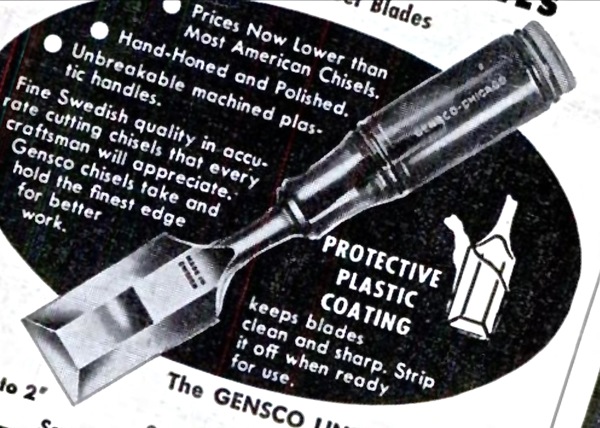


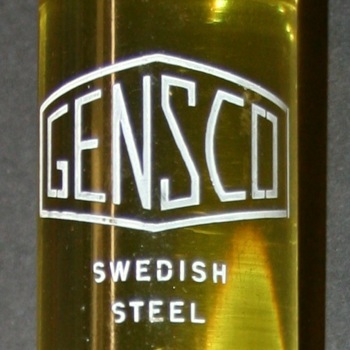
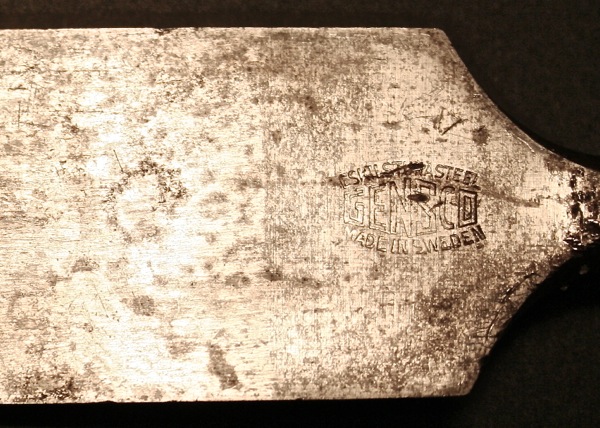
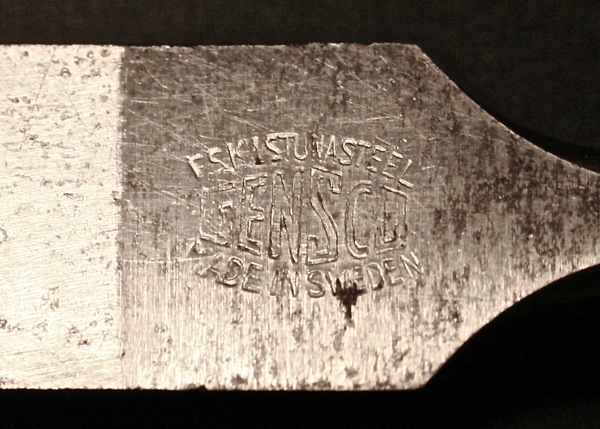
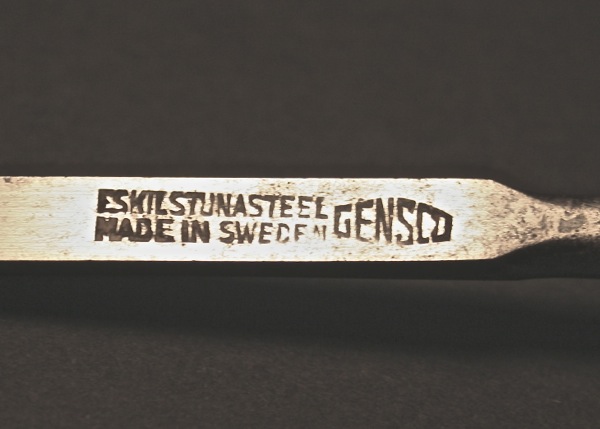
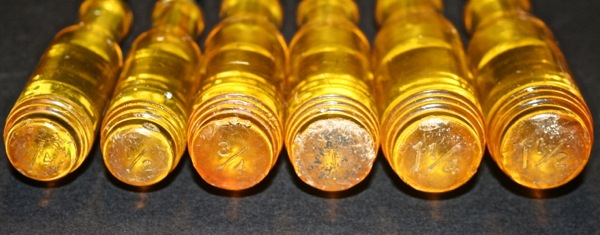
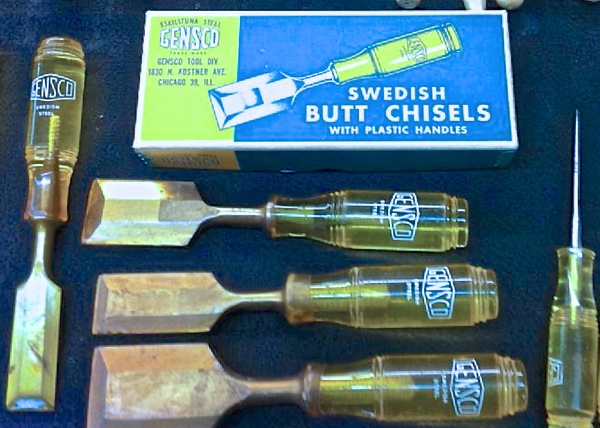

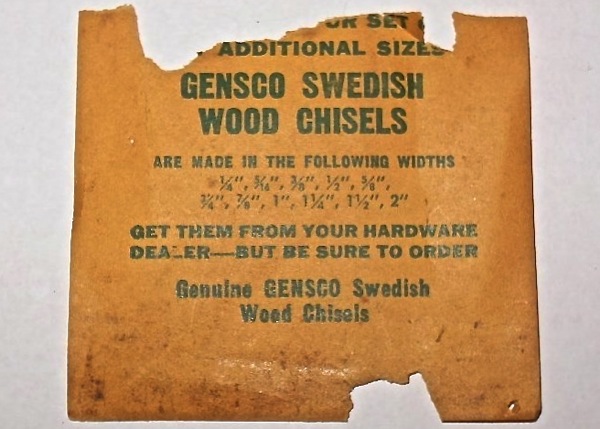
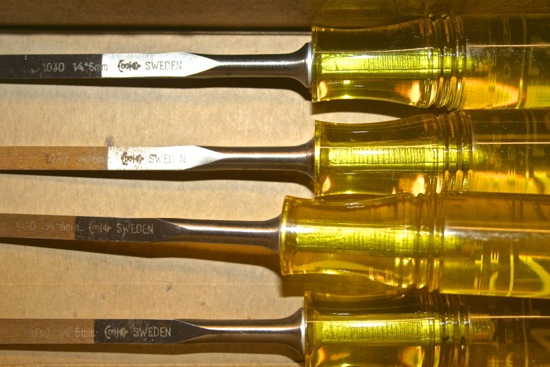
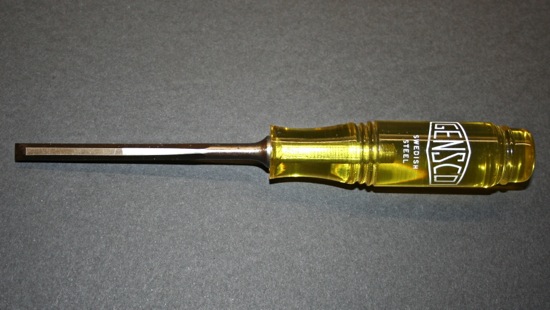
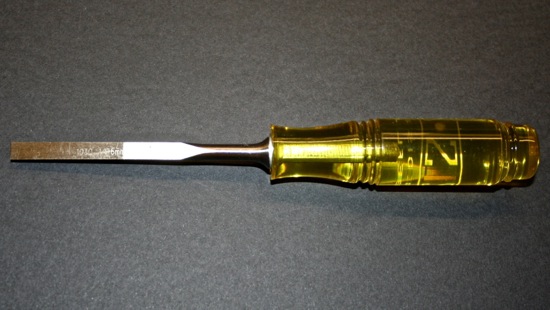

So the Gensco brand only had a 12 year run, with possibly only two years of wood handle production? What a short window of opportunity. No wonder the nice wooden handles are so rare! Many of the Gensco plastic handles I have seen are very orange- do you think that is because of UV action or was one style of plastic more likely to turn orange over time? Thanks for all this info- you’ve done a lot of research on this post. You must have looked at the ads in the back of every issue of Popular Mechanics from 1945 to 1965. Great job!
Thanks, Randall. I did look a a lot of old Popular Mechanics magazines before writing that article. 🙂
Yes, the wooden-handled Gensco’s are really attractive and were only available for a short while.
The early plastic Gensco chisels seemed to deteriorate and turn orange worse than the later ones. I believe that’s because Eskilstunasteel eventually changed the formulation for the plastic handles from cellulose acetate to cellulose butyrate.
Two things that you mention that I have never noticed- Gensco chisels with Beech wood handles and the sizes stamped onto the tops of the plastic handles. I’ll have to look more closely at some of my oldies and see what I find.
It was quite a while before I noticed the sizes stamped into the tops of the Gensco plastic chisel handles.
Very impressive.
Thanks.
Here is another observation: the Gensco dealer ad you show, for 1946, illustrates longer bladed beveled firmer style chisels, but then the next ad, for 1948, shows only butt style chisels. I have one long blade Gensco with an original wood handle. It is the only one I have ever seen and I am guessing it is probably from that very early post-war era, when Eskilstunasteel first put their Gensco brand chisels on the market in America.
Good information here; thanks very much for this detailed post.
I have a couple of E.A. Berg chisels and like the steel and
the way they’re made, and was looking for info on a Gensco
chisel I saw on ebay, which I’ll now probably pick up.
i was using my Dad’s Gensco Chisels 300-4 set tonight that he purchased around 1956, and barely ever used. Evidenced by the tops of the chisels don’t show any signs of hammering and wear. After he passed away in 1986, I acquired them and used them once in the late 1980s. They’re so beautiful and so sharp and such amazing quality, I did a Google search to see what I could find about them, and found your article. I needed a wood chisel tonight on a wood drawer I was repairing, and remembered the GENSCO chisels, and they completely made the task a cinch. Anyway, I thought you’d enjoy knowing there exists an essentially “MINT IN BOX” set of GENSCOs out there in the world. I may actually use them again in another 25 years, but they are beauties.
Nice! I’m sure that those chisels have extra special meaning to you having belonged to your Dad.
I recently found a rusty Gensco 3/4″ chisel($1.00) at my local swap meet with a very deteriorated plastic handle which was wrapped in electrician’s tape to hold it (mostly) together. A few swift blows from my hammer got rid of the plastic–sorry I didn’t identify it first–and now I am making a wooden handle as a replacement, which may further complicate your excellent research should my model ever come to light. How do you rate these chisels in terms of quality? I have yet to sharpen and use this one, but I’m looking forward to doing same. The rust did not seriously impair the blade, and the makers mark and the cutting edge seem to be fine.
I find the steel in the Gensco chisels to be pretty good. 🙂
Thank You!
I was wondering about these chisels and now I know.
I found a brand new set of 6 in one of our store rooms. The tools are in the vynil tool roll as you have shown. I can’t dig through 10s of thousands of check stubs to find out, but it is very likely that they have been there since the room was built in about 1970 and they were likely stored in a cabinet somewhere before that. The woodshop/pattern shop was equipped with Stanley chisels including the steel capped butt chisels that would have held the greater market share at the time these were being sold.
This Gensco set was probably purchased on sale in about 1960 and left on the shelf until it was forgotten. Given that we most commonly used butt chisels as a struck tool, anyone that did see them would have left them there in favor of the Stanley’s of which I found one set new, still in the yellow plastic blowmolded case, labeled “professional” from the early 1990s. Those later Stanleys were fine for cutting hinge butt mortices and even other light morticing work but the bevel edges were often poorly ground making them less effective for dovetail work than the earlier tools. These Gensco tools from the 1950s have a well ground bevel edge and look like they would have made a great all purpose chisel. It is likely that no one ever wanted to abuse the handles. We had plenty of good chisels for the occasional blind dovetail work that had to be done and so they sat. In the US there was a lot more hand cut dovetail work done prior to the 60s than during and later.
These and some Sandvic saws are amoung the very few examples of Swedish steel tools I have found in our shops.
Sadly, my father passed away in August of 2020. Our business and all of its tools are part of his estate. The greater part of a collection that began with my various great grandfathers before the turn of the last century and continued up to the present by my father, his brothers my brothers, their kids, and myself is being inventoried, priced, and sold online. Yet another little legacy of enterprise will be lost. This one started with a pre-war brick factory and post-war apliance repair shop in Gering NE on one side and a 19th century hard-scrabble ranching and post-war grain elevator and trucking enterprise in the area of Sterling CO on the other. The small brickyard was closed by the end of WWII and with our agriculture reduced to one pasture and a farmstead by the mid 1980s we survived two decades into this millennia as a business and family of Millwrights. We had a variety of shops and diverse skill sets in the trades. I can truly appreciate what a remarkable set of tools this is and the history behind them. For vintage tools, they are really a modern product and the need for them has not so much passed as the demand for them by skilled tradesmen. Niche craftsman and woodworking enthusiasts has kept a small portion of the market for such tools alive but modern economy has taken the culture and the training out of the general trades. There is little margin left for skilled woodwork in modern enterprise. For me, this once ordinary, if extraordinary, set of butt chisels is a metaphor.